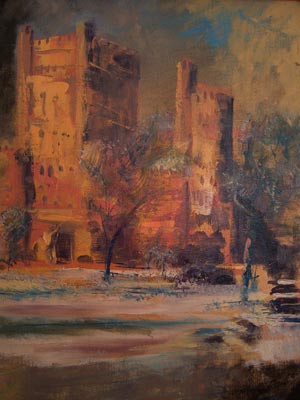Next story: The Things We Keep: MacKrell Collage Archive Project
Paint the Town: Raleigh Spinks Retrospective
by Judy Einach
Raleigh Spinks retrospective at Art Dialogue Gallery
I am not an art critic. But I knew Raleigh Spinks (1926-2005), at least through his final years, and I know when I’m seeing art I like, even love. Entering Art Dialogue, flowers jumped off the walls, or perhaps I just wanted to jump into this garden of delights. Technically each watercolor is a still life, but their separate and collective appeal drew visitors toward them like bees, creating a roomful of vibrancy. My eyes would never tire of any one of these paintings.

Across the room were what I learned are architectural images. At first I didn’t understand what skilled artists meant when they referred to Raleigh’s architectural work. I could only think of buildings. What I saw in the gallery were scenes of Buffalo’s waterfront—familiar, obvious, yet Raleigh’s expression makes Buffalo the most magical city in the world. Where I may see gray and blue, Raleigh saw the full spectrum of light and color.
By training and trade Raleigh was an urban planner who worked for the cities of Philadelphia and Chicago and for Erie County. One of the visitors at the exhibit on opening night, an artist himself, described Raleigh’s work as “loose.” The structure of things is clear to the eye but defined by only a line here and there. The rest is color. Raleigh used color to define what we see. Color, not line, gives structure to his work. I can only imagine what our living space would be like if a “loose” artist planned our urban environment.
These images of our waterfront must be preserved as a collection. I can see them hanging in the informal galleries of our established businesses, in firms whose executives collect art that pays tribute to our city and to those of us with talent. I imagine that working in a place where I could see Raleigh’s vision everyday would make my workday environment uplifting and more productive. Who wouldn’t want to give their all to the most magical city in the world?
Two small watercolors hung on a narrow wall are so typically Raleigh, taking us from the sublime to the amusing. They are images of Buffalo Auto Wrecking. They show cars, no longer running, all a-jumble, yet described by Raleigh as full of color and form. Raleigh found celebration where others see something to overlook.
Raleigh loved the working man. In this exhibit are images of Buffalo’s grain scoopers, airmail pilots, and card players. He loved the human form. Included in the exhibit are nudes of both women and men. The nudes of women are studies of various poses, composed in such a way that the figures seem to dance all over the page. These are not images of women who act as hangers for fashion. These are women with muscle and flesh who look comfortable to the touch. It appears that the models were having as much fun as the artist.
The nudes of men are different. They too have muscle, tone, and strength, but they are painted as full-body portraits, not as studies. They are striking and gorgeous.
There is one seemingly but not really dark watercolor, in far more muted tones, browns and grays. The title is Death at West Valley. Originally Raleigh titled it Death Arrested. Just as the West Valley nuclear site stands in stark contrast to the rural landscape around it, this painting is in sharp contrast with the rest of the exhibit. It isn’t pretty, but it is hopeful. The Grim Reaper is in chains being taken away by another man, perhaps a federal marshal. Would that one day the federal government agrees to take away the nuclear wastes in our Western New York environment, freeing us from this death threat.
This exhibit includes an array of Raleigh’s interests and styles. Besides Buffalo’s waterfront there are an amazing portrayal of the Shoreline Apartments, rural landscapes in several seasons, images from the perspective of being on the Erie Canal and passing through Lock 29, and the Pittsford coal tower on the canal in Monroe County. There are everyday scenes in the towns of Aurora and Hamburg.
Raleigh Spinks died at the age of 79. He painted almost to his end. He was a quiet man who won many awards for his artwork but who didn’t seek fame. If we allow him to be forgotten, we will have missed one of the greats in our community. This is not an exhibit to be missed. Whether you go to lift your spirits or to lift your spirits and invest, you’ll be better for having gone. The exhibit runs through June 6, 2008. Art Dialogue Galley is open Tuesday through Friday 11-5, Saturdays 11-3. It is located in Buffalo at One Linwood Avenue at North.
—judy einach
blog comments powered by Disqus|
Issue Navigation> Issue Index > v7n20: Dig The Tomato Man (5/15/08) > Artshorts > Paint the Town: Raleigh Spinks Retrospective This Week's Issue • Artvoice Daily • Artvoice TV • Events Calendar • Classifieds |









 Current Issue
Current Issue